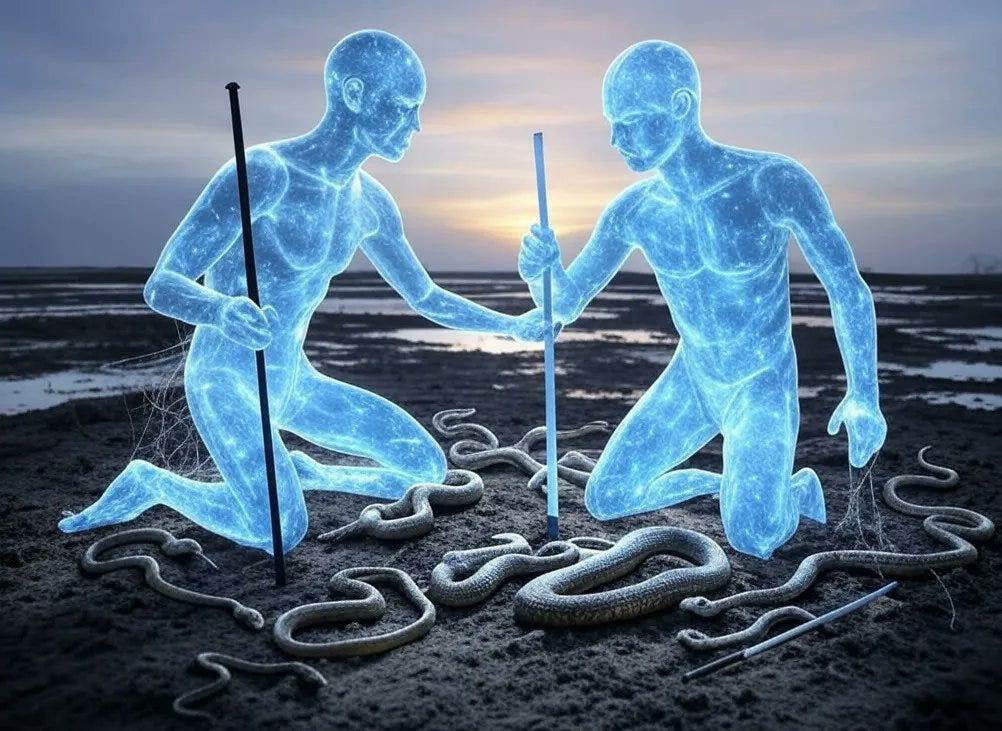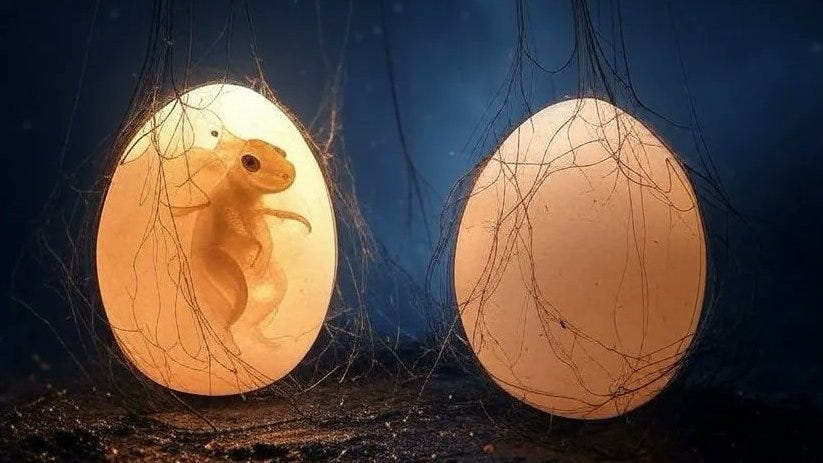This story, "Origin of the Cahuilla," is a reinterpretation of the story told to UC Berkeley Anthropologist Lucille Hooper , who did an oral history project with the Cahuilla people in the early 20th century.
In the beginning, there was no earth, sky, sun, or moon; only a vast and impenetrable darkness filled the void. This darkness, alive and pulsating, carried within it the seeds of creation. Sparks of light, like fleeting lightning, pierced the darkness, and from their meeting arose two luminous eggs. These eggs, suspended in a web woven from the strands of the Darkness itself, began to grow and pulse with life. When they hatched, Mukat and Tamaioit emerged, fully formed, their first breaths echoing in the void.
Mukat, the elder brother, and Tamaioit, the younger, sought to dispel the suffocating darkness. Mukat reached into his being and drew forth a cricket, a lizard, and a human form, releasing them to push back the shadow. Tamaioit, not to be outdone, contributed his creations, yet still, the darkness remained strong. Together, the brothers devised a plan to create light. They formed tobacco from their hearts and crafted pipes to smoke it, the fragrant clouds illuminating their surroundings like a rising dawn.
Then, Mukat and Tamaioit turned their attention to the foundations of the world. From their hearts, they drew rods—one black, one white. They set these as the roots of the earth, supporting them with snakes and binding them with spiderwebs that stretched to the corners of the dark expanse. Upon this framework, they poured a substance from their mouths, spreading it across the void to form the land. To dry and solidify the earth, they created whirlwinds, brush, and insects, which labored tirelessly until the earth was firm and whole.

As the earth settled, they shaped the sky from metal, embedding it with stars to bring light to the new world. Together, they fashioned the oceans, filling them with life, and then began creating people to inhabit the land. Mukat made people dark in hue, while Tamaioit made them light, reflecting the balance of the cosmos. Yet, as they labored, disagreements arose, and their creations bore the marks of their rivalry—a testament to their shared yet distinct visions for the world.
The discord between Mukat and Tamaioit grew as they shaped their creation. Mukat sought perfection in all things, crafting with patience and precision. He desired that humans walk upright, speak with clarity, and possess endurance. Tamaioit, in contrast, favored speed and efficiency. He hurried his work, creating beings with crooked limbs and impermanent forms. The brothers quarreled over these imperfections, their conflict shaking the still-forming earth.
Finally, their disagreement reached its peak when Mukat declared that death must be part of life’s cycle to sustain balance. Tamaioit vehemently opposed this idea, believing that life should remain eternal. Unable to reconcile their differences, Tamaioit, in anger, withdrew from the world and descended into the underworld, cursing Mukat’s creation as he left. From that day, death entered the world, bringing sorrow but also renewal to the cycles of existence.
Mukat, now alone, sought to perfect his creation. He gave humans fire to protect and nourish them and taught them sacred rituals, songs, and dances to connect with the spirit world. He showed them the ways of hunting and gathering, the secrets of plants, and the paths of the stars. To guide the people, Mukat created the first shaman, imbuing him with the knowledge to interpret dreams, heal sickness, and mediate between the human and divine realms.
Yet Mukat’s rule was not without flaw. In his pursuit of perfection, he grew prideful, and his creations suffered under his demands. Some say his own people turned against him, refusing to follow his teachings. Recognizing his imperfection, Mukat withdrew to the heavens, leaving the world to humans. He vowed to watch over them from afar, ensuring the cycles of life and death continued as he intended.
Thus, the Cahuilla world was born, shaped by the collaboration and conflict of the two brothers. It remains a place of duality: light and dark, life and death, order and chaos—each an enduring testament to the cosmic balance Mukat and Tamaioit established at the dawn of time.

A Biography of the Cahuilla People
The Cahuilla people's story is one of adaptability and perseverance, a testament to their ingenuity in navigating the varied landscapes of Southern California. Nestled within a vast and demanding environment, they thrived across three distinct ecological zones: the towering mountains, the windswept San Gorgonio Pass, and the arid deserts of the Coachella Valley. Though starkly different, these regions became the canvas upon which the Cahuilla built a rich and enduring culture.
In the mountains, at elevations of around 4,000 feet, the Mountain Cahuilla carved out a life rooted in the natural bounty of forested highlands. The Pass Cahuilla found their place amidst the transition between the coast and the desert, while the Desert Cahuilla made their homes near the Salton Sea, in a land where survival demanded extraordinary ingenuity. It was here, in the arid heart of Southern California, that many Cahuilla traditions endured the longest, shielded from the incursions of the outside world.
The Cahuilla language, part of the Shoshonean family, connected the Cahuilla to neighboring tribes like the Luiseño and Serrano. Their cultural practices, too, reflected this kinship, although they remained distinct in their identity. Organized into two moieties—the Wildcat (Tuktum) and the Coyote (Istam)—the Cahuilla practiced a deeply rooted system of social and spiritual balance. Clans within each moiety often bore the names of their ancestral settlements, reflecting the tribe’s strong connection to place.
The Cahuilla’s ingenuity extended to their daily lives. They built earth-covered homes to shield themselves from the elements and created sweat houses, or hoyachet, not only for physical purification but also as centers of spiritual practice. Their diet was a marvel of resourcefulness, relying on the mesquite tree’s beans as a staple food, especially in the desert. Every aspect of their environment was put to use: mesquite bark for tools, rabbit skins for clothing, and desert plants for sustenance.
Their spiritual world was as profound as their practical one. At its center stood Mukat, the creator, who shaped their cosmos and defined their relationship with the natural world. Shamanistic rituals, filled with symbolism and sacred songs, tied their survival to their spirituality. Oral traditions passed through generations ensured the endurance of their beliefs and stories, rooting them deeply in their land and their identity.
A Deeper Meaning
At its heart, the Cahuilla creation story is a cosmological narrative of contention, negotiation, and compromise. Mukat and Tamaioit, the divine siblings, symbolize an archetype of duality—two creative forces bound by collaboration yet fractured by irreconcilable philosophical differences. This tension underscores a persistent motif in California Native American mythology: the inevitability of conflict as a driver of creation and transformation.
This tension fits neatly within the broader history of California’s Native peoples, emphasizing the story’s role as a narrative of survival and adaptability. The discord between Mukat and Tamaioit mirrors the physical and spiritual struggles faced by the Cahuilla people as they navigated a harsh desert landscape. The brothers’ dispute over mortality echoes a deeper cultural truth: life’s fragility necessitates resilience and resourcefulness, traits essential to thriving in the arid Southern Californian environment.
Moreover, the story’s emphasis on duality and cosmic balance reflects the Cahuilla’s ecological consciousness, a theme central to their identity. The narrative presents the natural world not as a backdrop to human existence but as an integral part of the spiritual and material order. Mukat’s teachings on rituals and the use of fire underscore this connection, rooting human survival in the responsible stewardship of resources.
The withdrawal of both brothers—Tamaioit to the underworld and Mukat to the heavens—symbolizes a rupture in divine oversight, leaving humans to navigate a complex, self-regulating world. This is emblematic of the Native struggle against external forces, such as the missionization of California, that disrupted traditional knowledge and systems. The absence of Mukat and Tamaioit from daily life leaves humans empowered yet vulnerable, a narrative prelude to historical encounters with colonial powers that forced similar reckonings.
The Cahuilla’s narrative of creation and its inherent tensions can be seen as a metaphor for the broader Californian experience—a landscape where identities, cultures, and power dynamics have clashed and coalesced over centuries. In this way, the creation story is both a mythic account of the universe’s origins and a deeply resonant allegory for the enduring struggles and triumphs of the Cahuilla people within a contested historical and cultural landscape.
The Cahuilla creation story is more than mythology; it becomes a lens through which we examine the intersection of culture, environment, and historical memory in California’s indigenous past.
BIBLIOGRAPHY
Lucile Hooper, The Cahuilla Indians, University of California Publications in American Archaeology and Ethnology, Vol. 16 (Berkeley: University of California Press, 1920), 317–328.






